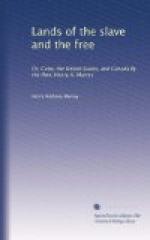The extent to which the telegraph is used in the United States, induced those interested in the matter in England to send over for the most competent and practical person that could be obtained, with the view of ascertaining how far any portion of the system employed by them might be beneficially introduced into our country. The American system is that of the complete circuit, and therefore requiring only one wire; and the patent of Bain was the one experimented with, as requiring the slightest intensity of current. After considerable expense incurred in trials, the American system was found decidedly inferior to our own, solely owing to the humidity of our climate, which, after repeated trials, has been found to require a far more perfect insulation than is necessary either in the United States or on the Continent, and therefore requiring a greater outlay of capital in bringing the telegraphic wire into a practical working state; 260 miles is the greatest length that a battery is equal to working in this country in the worst weather.
Bain’s system was formerly not sufficiently perfected to work satisfactorily in our climate; recent improvements are removing those objections, and the employment of it is now rapidly increasing. The advantages that Bain’s possesses over Morse’s are twofold: first, the intensity of current required to work it is lighter; and secondly, the discoloration it produces is far more easily read than the indentations of Morse’s. The advantage Morse’s possesses over Bain’s is, that the latter requires damp paper to be always ready for working, which the former does not. The advantage Cook and Wheatstone’s[BI] possesses over both the former is, that it does not demand the same skilled hands to wind and adjust the machine and prepare the paper; it is always ready at hand, and only needs attention at long intervals, for which reasons it is more generally employed at all minor and intermediate stations; its disadvantages are, that it does not trace the message, and consequently leaves no telegraphic record for reference, and it requires two wires, while Bain’s or Morse’s employs but one; the intensity of the current required to work it is the same as Bain’s, and rather less than Morse’s. All three admit of messages going the whole length of the line being read at all intermediate stations. The proportion of work capable of being done by Bain’s, as compared with Cook and Wheatstone’s, is: Bain’s and one wire = 3; Cook and Wheatstone’s and two wires = 5. But if Bain’s had a second wire, a second set of clerks would be requisite to attend to it. The errors from the tracing telegraph are less than those from the magnetic needle; but the difference is very trifling. No extra clerk is wanted by Cook and Wheatstone’s, as all messages are written out by a manifold writer. Every message sent by telegraph in England has a duplicate copy sent by rail to the “Clearing Office,” at Lothbury, to be compared with the original; thanks to which precaution, clerks keep their eyes open, and the public are efficiently protected from errors.




